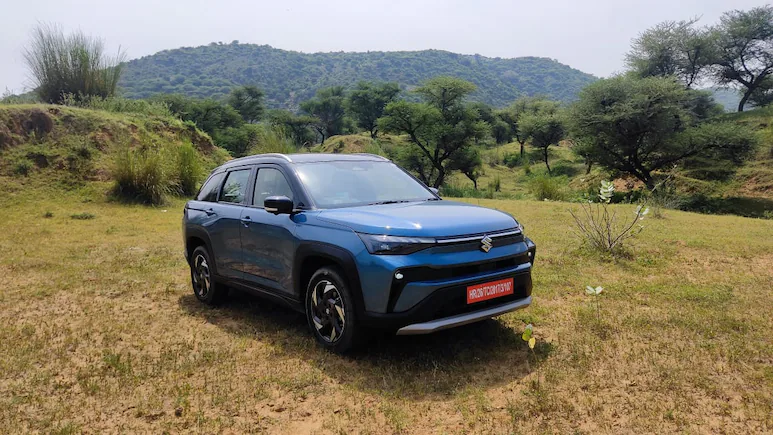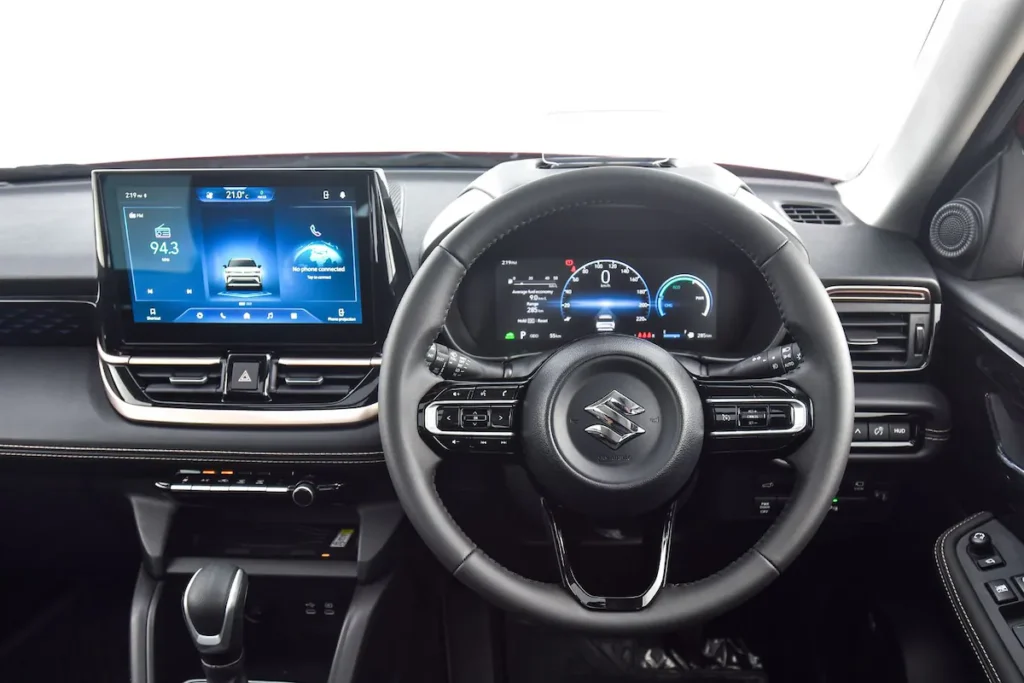Table of Contents
Maruti Suzuki Victoris: Specs, Price, Mileage & Features
What’s the Victoris All About

Maruti Suzuki has positioned Victoris as its second mid-size SUV, loaded with features and appealing to buyers who want something more premium than some entry options. It’s targeted at people comparing the Hyundai Creta, Kia Seltos, Honda Elevate and similar models. The big selling points include multiple powertrains, high equipment levels, a strong B-NCAP safety rating, and premium finishes.
Exterior & First Impressions
The Victoris borrows design cues from Maruti’s Brezza and e-Vitara. It has signature DRLs, a wide bonnet, split headlamps, pronounced wheel arches and a somewhat sloping roofline. Rear design gets a split-bar LED tail lamp for a broader visual impact. Dimensions are roughly 4360 mm length, 1795 mm width, 1655 mm height, with a 2600 mm wheelbase (same as Grand Vitara). This gives it decent road presence, but the rear roof slope could affect rear headroom.
Interior & Features: What You Get
The top trims (ZXi / ZXi+) bring in leatherette upholstery (black-ivory or all-black with gold/silver accents), which elevate the sense of refinement. The dashboard is layered, ambient lighting is well applied, and materials feel decent for the price. Key tech includes a 10.1-inch SmartPlay HD touchscreen, a 10.25-inch digital driver display, a 360-degree camera setup, wireless Apple CarPlay/Android Auto, ventilated seats, powered tailgate with gesture control, head-up display, and multiple USB-C ports. Comfort is good up front; rear seating for two is comfortable, but for three it becomes tight — particularly for taller people. The boot is decent in most variants, though the strong hybrid version has a smaller boot because of the raised floor.
Safety & Driving Aides

Victoris scores a 5-star rating in BNCAP (and GNCAP), which will matter for safety-conscious buyers. It comes equipped with 6 airbags, electronic stability program, hill-hold assist, traction control, ISOFIX anchor points, and tyre-pressure monitoring (on all but the base trim). Level-2 ADAS features are included (in relevant trims) and seem to be tuned to Indian road conditions.
Engine, Fuel Efficiency & Drive Experience
Powertrain options are varied: a 1.5 L naturally aspirated mild hybrid producing about 103 hp, a strong hybrid version with around 116 hp, and a CNG variant with ~89 hp. Mileage claims are good, with the mild hybrid petrol offering ~21 kmpl, the strong hybrid close to 28.65 kmpl, and the CNG ~27.02 km/kg. Driving around town is well handled by the mild hybrid automatic version, while the strong hybrid has more zip. Upshifts and downshifts are tuned for efficiency, which sometimes reduces responsiveness during overtakes. The car rides comfortably, deals with potholes decently, though cambered or broken roads may reveal firmness in suspension, especially in variants with more weight. Steering is light in town and more composed at higher speeds.
Price & Variants
Pricing (ex-showroom, India) ranges approximately from ₹10.49 lakh for the mild hybrid base model to around ₹19.98 lakh for the top strong hybrid variant. CNG options fall in the mid-range at ₹11.49-₹14.56 lakh. One key drawback is the absence of a spare wheel in any variant — only a puncture repair kit is standard, though a spare can be added as an accessory. This may matter depending on where you drive.
What’s Good, What’s Not
Pros include a very feature-rich offering for its segment with ADAS, hybrid options and strong safety ratings, multiple powertrain choices, and premium interior feel in higher trims. Cons include rear headroom being tight for taller passengers, no spare wheel as standard, strong hybrid versions adding weight that can affect ride, and the top trims getting close in price to rivals that offer more powerful turbo or diesel engines.
Should You Consider Victoris?
If you’re someone who values a packed feature list, safety, hybrid options, and premium touches in a mid-size SUV, Victoris is strong value. It especially makes sense if you drive frequently in cities or want lower running costs with hybrid or CNG. If your priority is outright performance, or if rear-seat comfort for three grown adults is a must, you might want to test it against rivals.
FAQs for Prospective Buyers
Is the strong hybrid version worth the extra cost? Yes, if you do enough driving to benefit from its superior fuel efficiency and want smoother performance, particularly in stop-and-go traffic or on highways.
How does the CNG variant compare in operating cost? CNG offers savings, but with downsides like lower power, fewer fueling stations depending on location, and slightly more maintenance vigilance.
What are maintenance and service concerns? Maruti’s service network in India is strong, so parts and servicing may be easier and cheaper compared to less popular brands. But variant-specific components like the hybrid system may cost more.
How does it stand vs Hyundai Creta and Kia Seltos? Victoris offers more features and a broader mix of engines and hybrids. Rivals may have turbo petrol or diesel engines which appeal to some. Look at your usage patterns — city vs highway and fuel availability — when comparing.
Does it retain value well? Maruti generally has good resale and parts availability, which helps. The newer hybrid and safety features may help maintain a premium in resale value if they remain in demand.
A Buyer’s Perspective
Maruti Victoris looks like a smart move for buyers who want a well-rounded mid-size SUV without having to compromise much on tech, safety, or variety. It leans more toward comfort and efficiency than outright sporty thrills. For many, it may check more boxes than its rivals. If I were picking, the strong hybrid makes the most sense for highway and long-distance drivers, while the mild hybrid is best suited for primarily urban commutes.
